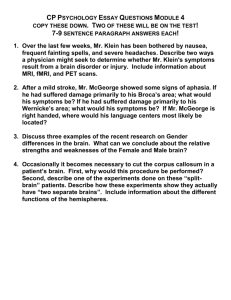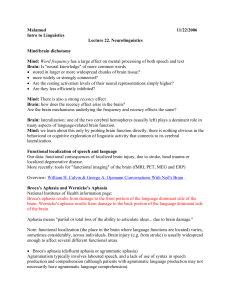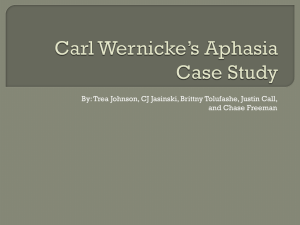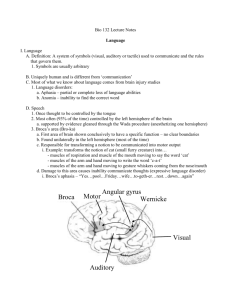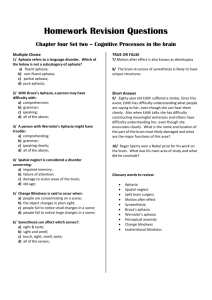ling411-19 - Rice University
advertisement
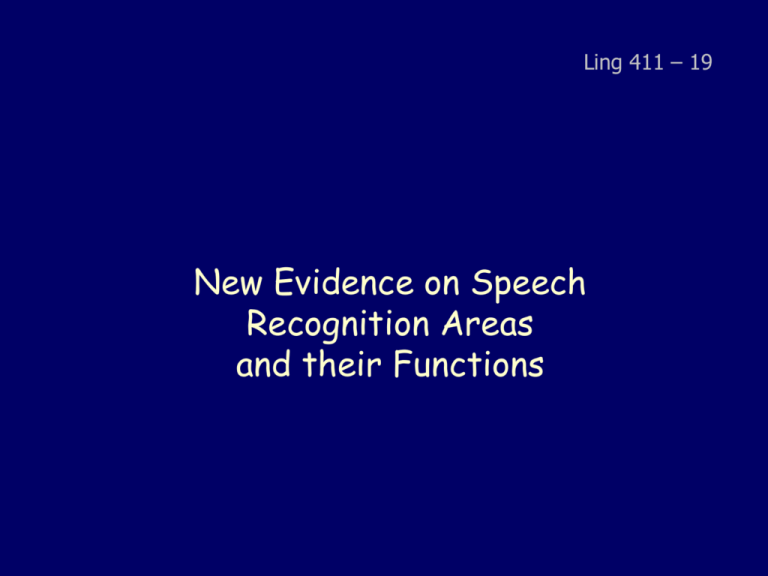
Ling 411 – 19 New Evidence on Speech Recognition Areas and their Functions Schedule of Presentations Tu Apr 13 Th Apr 15 Tu Apr 20 Th Apr 22 Delclos Planum Temp Banneyer Categories Ezell Lg Dev. (Kuhl) Ruby Tso Writing Rasmussen 2nd language Bosley Synesthesia Brown Lg&Thought Koby Music Mauvais LH-RH anat. Tsai Tones Delgado Amusia Valuable Lessons from G. Hickok The role of Wernicke’s area in speech production • Confirms what we have already learned Another type of conduction aphasia The role of the right hemisphere in speech perception A new explanation of “word deafness” The role of Broca’s area and SMG in phonological working memory The role of SMG in speech production and repetition On the other hand .. One proposal of Hickok is not so good! • Arcuate fasciculus Not a direct connection (acc. to Hickok) (later) Wernicke’s area in speech production “What I would like to suggest is that Wernicke was essentially correct in hypothesizing … that auditory cortex participates in speech production …” (Hickok 2000: 89) Hickok quotes Wernicke: Observations of daily speech usage and the process of speech development indicates the presence of an unconscious, repeated activation and simultaneous mental reverberation of the acoustic image which exercises a continuous monitoring of the motor images. Wernicke 1874 Evidence for left pSTP involvement in speech production Erratic speech of Wernicke’s aphasics Conduction aphasia from damage to left pSTP Intraoperative stimulation of left pSTP • • “distortion and repetition of words and syllables” (Penfield & Roberts 1959) N.B.: As in Wernicke’s aphasia MSI study shows activity in left pSTG just before speech production (picture naming) (Levelt et al. 1998) fMRI study: similar results – no RH activity shown (Hickok et al. 1999) (Hickok 2000: 93-4) An MSI study from Max Planck Institute Valuable Lessons from G. Hickok The role of Wernicke’s area in speech production • Confirms what we have already learned Another type of conduction aphasia The role of the right hemisphere in speech perception A new explanation of “word deafness” The role of Broca’s area and SMG in phonological working memory Hickok’s proposal on conduction aphasia At least one type of conduction aphasia results from damage to phonological processing systems in auditory cortex which participate both in speech perception and in speech production • i.e., Wernicke’s area The asymmetry between production (impaired) and comprehension (spared) can be explained in terms of different degrees of lateralization in the … systems that support (or can support) these functions (2000: 89) Why isn’t this Wernicke’s aphasia? The area identified by Hickok for conduction aphasia is Wernicke’s area • Hickok claims that such damage is responsible for conduction aphasia Conduction aphasia and Wernicke’s aphasia • In conduction aphasia Comprehension is relatively ok • Hickok claims the RH pSTP also participates in speech recognition Patient is aware of errors in repetition • Hickok proposes that in Wernicke’s aphasia the damage extends beyond Wernicke’s area MTG (p. 101), (maybe also AG?) Hickok & Poeppel (2000) Left temporal-parietal-occipital junction area is “typically involved to some extent in Wernicke’s aphasia, which … has a prominent post-phonemic component to the deficit profile. (Toward a functional neuroanatomy of speech perception, p. 7) MR template – Wernicke Aphasia (patient I) Poster -ior portio n of superior and middle temporal gyri MR template – Wernicke Aphasia (patient II) Superior temporal gyrus, AG, SMG Repetition in Wernicke’s aphasia Repetition in Wernicke’s aphasia Model for Repetition black Patient’s Response blackboard shoe shoelace He parks the car He park … he came with the car. He came with his car. It goes between two others It went two cars … between the cars Valuable Lessons from G. Hickok The role of Wernicke’s area in speech production • Confirms what we have already learned Another type of conduction aphasia The role of the right hemisphere in speech perception A new explanation of “word deafness” The role of Broca’s area and SMG in phonological working memory Hickok’s proposal on speech perception The primary substrate for speech perception is the posterior temporal plane (pSTP) • pSTP – Heschl’s gyrus plus planum temporale Conduction aphasia can result from damage to exactly this area in left hemisphere Apparent paradox: • Comprehension is preserved in conduction aphasia Explanation: • Speech perception is subserved by pSTP in both hemispheres (2000: 90) RH involvement in speech perception Isolated RH Evidence from tests of isolated RH • Split-brain studies • Wada test • • Sodium amytol, sodium barbitol Discrimination of speech sounds Comprehension of syntactically simple speech (Hickok 2000: 92) Caution – Split-Brain Studies These patients are generally epileptics Usually the onset of seizures is several to many years before the surgery Often the onset of seizures was during childhood Therefore the brain has had time to adapt – perhaps reorganize some linguistic functions RH involvement in speech perception Intra-operative recording Evidence from intraoperative recording Sites found in STG of both hemispheres for • Phoneme clusters • Distinguishing speech from backwards speech • Distinguishing mono- from polysyllabic words (Hickok 2000: 92-3) RH involvement in speech perception Imaging Evidence from imaging • • • PET fMRI MEG • More activity in LH Subjects passively listen to speech Both hemispheres show activity Some evidence for differential contributions of the two hemispheres (Hickok & Poeppel, another publication) (Hickok 2000: 93) Some findings w.r.t. RH speech perception Vowel qualities Intonation Tones in tone languages Valuable Lessons from G. Hickok The role of Wernicke’s area in speech production • Confirms what we have already learned Another type of conduction aphasia The role of the right hemisphere in speech perception A new explanation of “word deafness” The role of Broca’s area and SMG in phonological working memory Word Deafness Also known as pure word deafness Profound speech comprehension deficit • • Inability to hear words as words Like Wernicke’s aphasia, but worse Wernicke’s aphasics have some speech perception ability Geschwind: disconnection of Wernicke’s area from speech input Hickok’s alternative: Damage to pSTP of both hemispheres Speech production similar to that in conduction aphasia (Hickok 2000: 94) • Paraphasia More on word deafness “… word deafness is the only aphasic syndrome dominated by a profound deficit in speech perception. …none of the left unilateral-lesion-based aphasic syndromes have a speech perception deficit as a major component of the syndrome, which in turn further supports the view that speech perception is mediated bilaterally.” Hickok 2000: 92 Valuable Lessons from G. Hickok The role of Wernicke’s area in speech production • Confirms what we have already learned Another type of conduction aphasia The role of the right hemisphere in speech perception A new explanation of “word deafness” The role of Broca’s area and SMG in phonological working memory Phonological working memory “… Broca’s area and the SMG are involved in speech perception only indirectly through their role in phonological working memory which may be recruited during the performance of certain speech perception tasks.” Hickok 2000: 97 “The sound-based system interfaces not only with the conceptual knowledge system, but also with frontal motor systems via an auditory-motor interface system in the inferior parietal lobe. This circuit is the primary substrate for phonological working memory, but also probably plays a role in volitional speech production. Hickok 2000: 99 But .. One proposal of Hickok is not so good! • Arcuate fasciculus • Hickok’s assertion: “… this auditory cortex-SMG-Broca’s area circuit replaces the notion of a direct sensory-motor link via the arcuate fasciculus. Connectivity studies in nonhuman primates is consistent with the claim that there is not a direct … connection between auditory cortex and the ventral posterior frontal lobe… “… auditory cortex … in the macaque monkey … does project to the parietal lobe which in turn projects to ‘Broca’s area.’ ” 2000:99 Arcuate Fasciculus The macaque monkey’s brain is not the same as the human brain The macaque monkey has no language! Better to rely on anatomical studies of the human brain. Arcuate fasciculus in primates Asif Ghazanfar, Nature Neuroscience 11:4.382-384, April 2008 Benson and Ardila on conduction aphasia “… a single type of aphasia may have distinctly different loci of pathology. Both conduction aphasia and transcortical motor aphasia are examples of this inconsistency.” (117) (See also p. 135) Hannah Damasio on conduction aphasia “Conduction aphasia is associated with left perisylvian lesions involving the primary auditory cortex…, a portion of the surrounding association cortex…, and to a variable degree the insula and its subcortical white matter as well as the supramarginal gyrus (area 40). Not all of these regions need to be damaged in order to produce this type of aphasia. In some cases without involvement of auditory and insular regions, the compromise of area 40 is extensive…. In others, the supramarginal gyrus may be completely spared and the damage limited to insula and auditory cortices … or even to the insula alone….” (1998: 47) CT template – Conduction Aphasia (patient I) CT template – Conduction Aphasia (patient II) Left auditory cortex and insula Kurt Goldstein on Conduction Aphasia Kurt Goldstein (1878-1965) • • • German Studied with Wernicke Influenced by Gestalt psychology (Koffka 1935) • • Became the best-known spokesman for this approach Important publication in 1948 • • Not the arcuate fasciculus but a central area Proposed the term ‘Central Aphasia’ Adopted a “holistic” approach Criticized the Wernicke-Lichtheim view of conduction aphasia Now we see that there are really three kinds of conduction aphasia Three types of conduction aphasia Damage to arcuate fasciculus • The classical one Proposed by Wernicke and Lichtheim Doubted by Hickok • But Hickok is wrong! Damage to SMG • Proposed by Goldstein • Supported by Hickok Damage to Wernicke’s area • New proposal of Hickok Possible 4th type: Damage to insula More on RH Linguistic Functions Inference, Metaphor Coarse coding Music Possible bases for RH/LH difference Higher ratio of white to gray matter in RH • Therefore, higher degree of connectivity in RH Difference in dendritic branching Different density of interneurons Evoked potentials (EEG) are more diffuse over the RH than over LH Beeman 257 Anatomical differences between LH and RH Geschwind & Levitsky (1968) • 100 brain specimens examined • Planum temporale • Larger in LH: 65% Larger in RH: 11% About the same, both sides: 24% Correlates with shape of Sylvian fissure Shorter horizontal extent in RH Goodglass 1993:60 Experiments (described by Beeman) Words presented to rvf-LH or lvf-RH RH more active than LH • Synonyms • Co-members of a category: table, bed • Polysemy: FOOT1 – FOOT2 • Metaphorically related connotations • Sustains multiple interpretations LH about same as RH • Other associations: baby-cradle LH more active than RH • Choose verb associated with noun Patients with brain-damage Some patients with LH damage • Can’t name fruits but can say that they are fruits Patients with RH damage • Impaired comprehension of metaphorical • statements More difficulty producing words from a particular semantic category than producing words beginning with a particular letter (258) Imaging studies When listening to spoken discourse, cerebral blood flow increases in • Wernicke’s area • Broca’s area • RH homologues of Wernicke’s and Broca’s areas More cerebral blood flow in RH when subjects read sentences containing metaphors than literal sentences Experiments on speech perception Dichotic listening – normal subjects • Right ear (i.e. LH) advantage for distinctions of • • Voicing Place of articulation Left hear (RH) advantage for Emotional tone of short sentences Sentences presented in which only intonation could be heard RH advantage for identifying sentence type – declarative, question , or command Experiments on speech perception Split brain patients • They hear a consonant • Then written representations are presented • ‘Point to the one you heard’ • rvf-LH exhibited strong advantage Patients with right-brain damage Posterior RH lesions result in deficits in interpreting emotional tone Anterior RH lesions abolish the ability to control the production of speech intonation Split-brain studies Isolated RH has ability to read single words • But not as fast nor as accurate as LH • Ability declines with increasing word length • Lexical context does not assist letter identification In Japanese subjects • RH is better at reading kanji than kana • LH is better at reading kana Musical abilities and the hemispheres Pitch, melody, intensity, harmony, etc. in RH Rhythm in LH Absolute pitch (if present) in LH temporal plane Musicians’ ability to analyze chord structures in LH Appreciation of chord harmony in RH Discrimination of local melody cues more in LH Timbre discrimination in anterior right temporal lobe Melody recognition in anterior right temporal lobe Evidence from results of brain lesions/surgery, from dichotic listening experiments, from Wada test experiments, and from imaging end
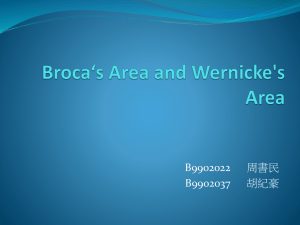
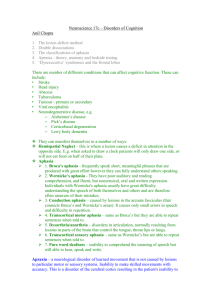

![Wernicke`s_area_presentation[1] (Cipryana Mack)](http://s2.studylib.net/store/data/005312943_1-7f44a63b1f3c5107424c89eb65857143-300x300.png)
